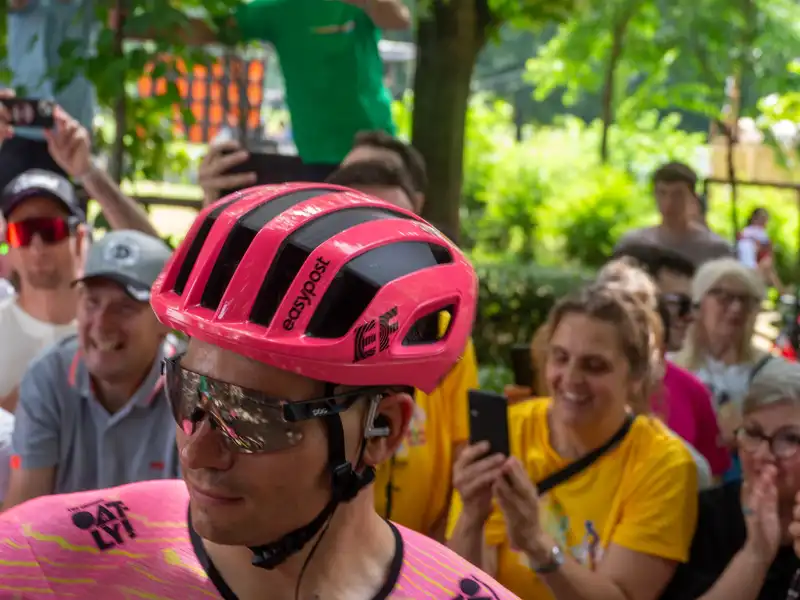This year's Tour de France is a hotbed of new technology, and nowhere is that more true than in helmets. [EF Education-Easy Post, Intermaché-Wanty, and Bahrain Victorious. 2024 is going to be the year of the helmet, and EF Education-Easy Post is already making waves with its POC Prosen Air, which combines the design of a time trial helmet with the comfort of a road helmet. The POC Procen-Air, which combines the design of a time trial helmet with the comfort of a road helmet, has already caused a stir.
And Visma-Lease a Bike almost broke the Internet with its new Giro TT helmet, which defies what we know about helmet design.
Luckily for the cycling fashion world, we didn't see anything quite so radical at this year's Tour, with POC and Rudy Project showing off their new vented helmets and Uvex choosing to go the route of a vented helmet with an optional aero cover.
When POC introduced the Procen Air at an early season race, the line between road and TT helmets blurred and attracted a lot of media attention. Now the dust has settled and POC has once again introduced the Pro Helmet.
The new helmet does not appear to be labeled, but its large, vented design leads us to believe that it is either an update of the existing Ventral or a new model to replace it.
At first glance, the helmet's blunt front face catches the eye, with a nearly 90-degree edge separating the front face from the top of the helmet.
This design is unusual, however, in that it features five large front vents that go directly into the airflow. These huge air intakes, by their location and size alone, would allow riders to keep their heads cool in hot conditions.
Past the large front vents, the top of the helmet is broken up by only two small vents toward the rear of the helmet, which divide the top section that is otherwise covered. The pink ridges are more pronounced than the darker areas, and while not a completely smooth top, this section of the helmet was certainly designed with aerodynamics in mind.
The rear of the helmet has a rather blunt profile where a series of large exhaust outlets come together to form a large hot air exit. We have seen blunt helmet profiles in the past that allow the rider to assume an aero position without compromising the performance of the exhaust outlets.
Stage 3 winner Biniam Girmay's team, Intermache Wanty, wore a rather impressive new helmet on the opening stage of the Tour. The camouflaged helmet uses an outer shell cover to hide the vents and improve aerodynamics.
The unmarked helmet eliminates the vents and has five channels running almost the entire length of the helmet to direct cooling air over the rider's head. There are only a few carbon fiber struts connecting the channels of the helmet, which break up the vents.
With the removable aero shell, the helmet takes on a distinctly aero form. The two outer grooves are completely covered, while the three central grooves are reduced to small vents only a few centimeters from the eyebrows.
The removable aero cover has already caused a bit of a stir, as teams have attached the shell with superglue to comply with UCI (International Cycling Union) regulations. This is because removable aero covers on helmets are prohibited for use in competition.
With or without the aero cover, the exhaust vents at the rear remain the same. The four large central exhaust vents direct the passing airflow away from the rider.
As with the Giro, the Rudy Project has already introduced a new helmet this year, the Wing Dream TT Helmet. Since then, the brand has continued to release the Rebel, a vented helmet that it claims "sets new standards in safety, sustainability, and performance."
Carbon fiber is used in the construction of this new helmet, which reduces the amount of polystyrene used. This reduces the overall footprint of the helmet and increases the size of the vents.
Externally, the Rebel is more traditionally styled than other newer helmets, with a series of vents located on the front and top of the helmet; in contrast to Uvex's helmet design, which uses five main continuous channels for cooling, the Rebel has an entire helmet Rebel uses 22 independent vents throughout the helmet.
In addition, recycled polycarbonate is used in the helmet's construction, and the padding and straps are also made from recycled materials.
The Rebel sits alongside the aero-focused Nytron, and the Bahrain Victorias team can choose between the two depending on the stage profile and weather conditions.
.

Comments